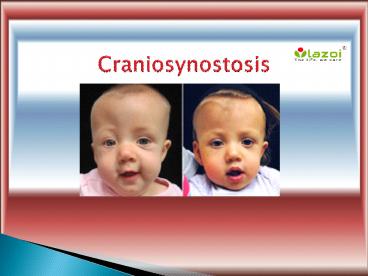Craniosynostosis: Types, Causes, Symptoms, Diagnosis and Treatment - PowerPoint PPT Presentation
Title:
Craniosynostosis: Types, Causes, Symptoms, Diagnosis and Treatment
Description:
Craniosynostosis is a rare but chronic condition, which affects the normal development of baby’s brain and skull. Craniosynostosis disorder affects the normal growth process, which involves bone displacement and bone remodelling. – PowerPoint PPT presentation
Number of Views:217
Title: Craniosynostosis: Types, Causes, Symptoms, Diagnosis and Treatment
1
Craniosynostosis
2
Craniosynostosis
- Craniosynostosis is a rare but chronic
condition, which affects the normal development
of babys brain and skull. The newborns skull is
made up of many separate bones, the fusion of
these bones, usually occurs later in teen years.
The early fusion of these bones in the newborns
skull causes Craniosynostosis. Craniosynostosis
disorder affects the normal growth process, which
involves bone displacement and bone remodelling.
This rare disorder can occur before or after
birth. The risk of developing Craniosynostosis is
equal among boys and girls. Craniosynostosis
occurs in one out of 2500 births.
3
Types of Craniosynostosis
- Metopic Synostosis- It occurs when there is a
fusion between sagittal structure and nose.
Metopic synostosis results in triangular
development of scalp. Lamdoid Synostosis- It is
the rarest type of Craniosynostosis and affects
the back portion of the head. Lamdoid Synostosis
results in twisted shape of skull. Coronal
Craniosynostosis- It occurs when there is an
early fusion between the coronal structures of
the skull, which affects the higher eye socket
and results in the flat development of the
forehead.
4
Causes of Craniosynostosis
- Doctors do not know the exact cause of
Craniosynostosis. However, genetic mutation is
stated as one of the most possible causes of
Craniosynostosis. Genetic mutation leads to the
defects in cell sutures that cause them to fuse
too early. Another possible cause of
Craniosynostosis is the irregular position of the
baby in the womb or putting excessive pressure
that can cause the early fusion of sutures.
5
Symptoms
- One visible symptom of Craniosynostosis is the
abnormal shape of the head. Early fusion of bones
restricts the normal growth of bone and skull.
The excessive pressure on skull results in the
development of learning disabilitiesand problems
with the eyesight. Frequent headaches and
developmental delays are other common symptoms of
Craniosynostosis.
6
Diagnosis of Craniosynostosis
- Initially, a paediatrician will try to diagnose
Craniosynostosis by performing a visual
evaluation and feeling for creases around the
babys skull. The doctor may order a blood
test to check if Craniosynostosis is inherited or
not. Imaging tests such as CT scans and Xrays
disclose the location of fused sutures.
7
Treatments
- Surgery is by far the only treatment available
for Craniosynostosis. Surgery to correct
Craniosynostosis is to be performed within the
first year of babys birth. If left untreated,
Craniosynostosis can get worse resulting in
increased deformity of the skull. Surgery for
Craniosynostosis involves the reformation of the
babys skull, by repositioning the fused sutures.
Dissolvable stitches are used to close the
incisions.
8
CONNECT WITH US
- Logon to
- www.lazoi.com
- Like us on Facebook
- https//www.facebook.com/LazoiTheLife
- Follow us on Twitter
- https//www.twitter.com/lazoithelife
- Follow us on Pinterest
- https//www.in.pinterest.com/lazoithelife































